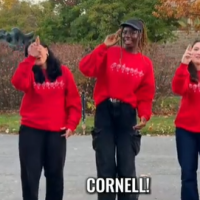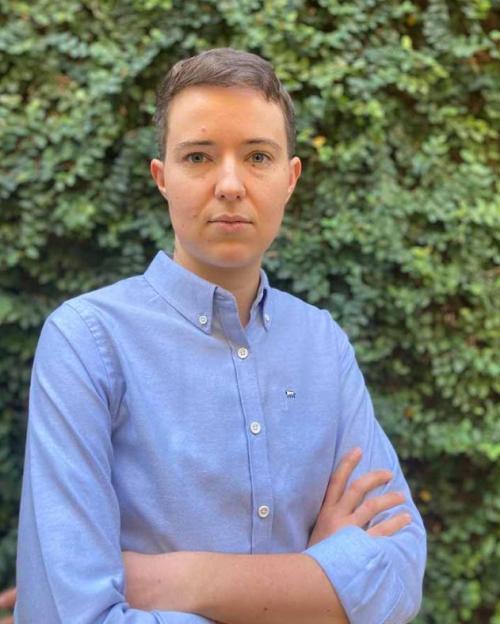Pointing, a simple gesture with complex ramifications, is unique to our species, according to linguist Amalia Skilton.
Skilton studies joint attention behaviors – when one person draws someone else’s attention to a third person or object using gestures or demonstrative words, such as “this” or “that” – and she said such behaviors are not seen in other primates.
“It’s seen to some extent in species that have co-evolved with humans, such as dogs, but it really is unique to humans,” said Skilton, a Klarman Fellow in the College of Arts and Sciences.
And although joint behaviors are seen throughout the human species, they are also very culturally diverse, Skilton said. Some cultures use an index finger; others an open hand or a head nod, and there are a whole array of demonstrative words language to language.
Based in the Department of Linguistics, Skilton will use the three years of her Klarman fellowship to study the range of joint attention behaviors. Her faculty host is Sarah Murray, associate professor of linguistics (A&S).
Skilton seeks the deeper implications for human communication, especially across cultures.
“I see joint attention as the infrastructure for the rest of social interaction,” she said. “It’s because we have joint attention that we are able to coordinate our actions on objects, to do things like exchange them, or label them with names.”
Skilton started field linguistics work immediately after undergraduate graduation, spending her 21st year traveling to various villages and towns in the Amazon basin. In graduate school, she worked with Máíhɨ̃ki, an Amazonian language with less than 100 speakers.
Then, in 2014, she overheard a group of young people speaking together in a tiny military airport in Iquitos, Peru and recognized that they were speaking an Indigenous language.
“I learned they were Ticuna people and this language was really under-researched. And I was excited to be able to work with people similar to me in age and to be able to study conversation.”
This random moment touched off an enduring relationship with Ticuna speakers in northeast Peru, and Skilton spent three or four months every summer in the region for the next five years. During that time, she learned the language, analyzed the grammar and asked questions about language structure and use, as well as getting to know community members.
She also recorded audio and video footage of 45 children, ages 12 months to five years, and their adult caregivers.
“We have this enormous, rich set of data of adults and children interacting,” Skilton said. “It’s a way of looking at both developmental questions and questions of adult interaction.”
We know that for adults, joint attention is everywhere Skilton said, but it looks different for adults in different cultures.
“So how do children get from no joint attention behavior as newborns to adult-like but extremely varied joint attention behavior?” she said. “Is there some default that has socially-learned behavior overlaid on it? Or is it the case that all of joint attention is socially learned?”
Through her work in Peru, Skilton has discovered that Ticuna children use index fingers to point, but they also use an open hand gesture just as much. Ticuna-speaking adults show a similar ratio of index finger points to open hand points.
“That contrasts with other cross-cultural studies that say infants everywhere prefer index finger pointing; and open hand pointing falls away as they mature,” Skilton said.
Joint attention development in children is widely studied, Skilton said: “specifically white middle-class kids in the United States. But it’s not particularly well-studied in any other group, in the U.S. or elsewhere.”
At Cornell, Skilton is excited to be in the same research environment as scholars from various colleges who approach her topics from different angles: psychologists in the College of Human Ecology as well as Arts and Sciences, and psycholinguists in the linguistics department. She is working with an undergraduate research assistant from the College of Human Ecology.
Skilton plans to return to northeast Peru in April, her first trip back since 2019, and she sees long-term collaborative possibilities in the region.
“There’s a lot of promise for bringing students with me there, for creating more of an intellectual community,” Skilton said. “I admire intellectual communities that have been created by people in different disciplines working in the same geographic area in Central America. There’s a lot of great scholarly community built on working with Mayan languages, for example, including scholars with Mayan backgrounds. I would like to recreate that for the Amazon basin, and it is my hope that Amazonia research circles can also come to include people with Indigenous heritage.”






